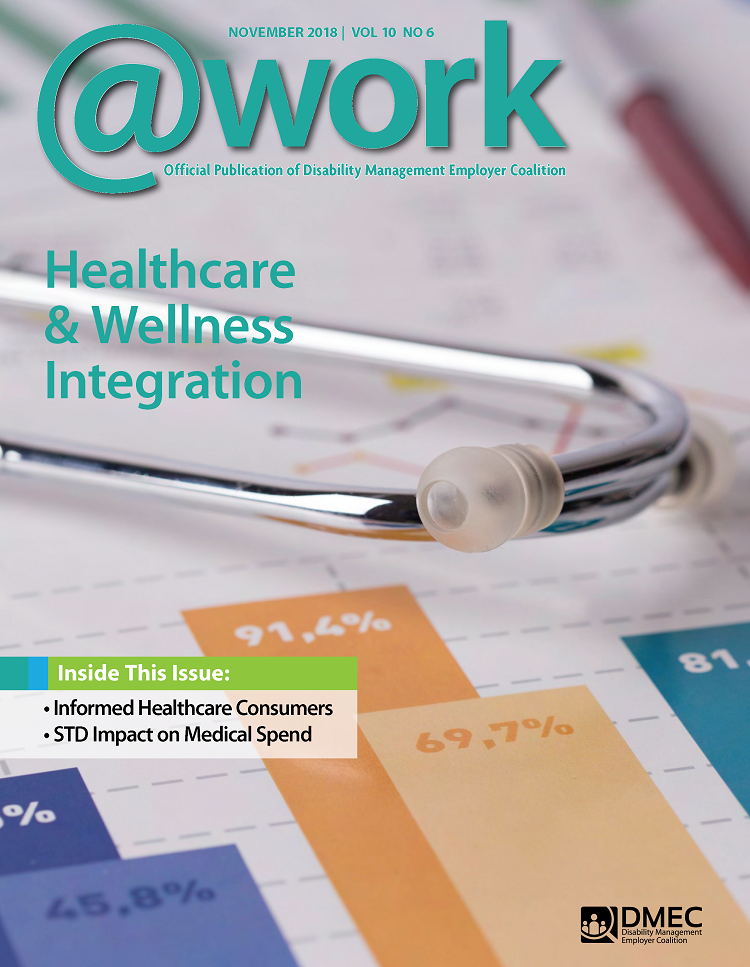
November 2018
Healthcare and Wellness
Health and wellness play an important role in keeping employees at work, reducing healthcare costs, and increasing productivity. This issue of @Work magazine features case studies and resources that will help you improve all phases of your programs.
Features
Employer-Provided Resource Fosters Well-Informed Healthcare Consumers
Some of the leading drivers of employee absenteeism and lost productivity are disability leaves due to employees’ ongoing management of chronic medical conditions or recovery from procedures. When consumers are provided with resources to become informed healthcare consumers, they are more likely to receive high-quality healthcare and have better health outcomes. Read more.

STD Plan Design Impacts on Health Plan Cost Trends
For many companies, benefit trends are viewed in isolation. This detachment of information means that the health plan leaders in these companies are lacking what could be a key indicator of their future spend. In particular, short-term disability impacts the health plan costs for any company. Read more.

Spotlight Articles
Program Showcase: Insourced Leave Management
Hackensack Meridian Health shares the challenges, advantages, and unexpected outcomes that they experienced when they brought their medical leave management program inhouse. Read more.

RTW Case Studies: Recurrent Work Disability
“Recurrence,” or multiple work leaves for the same or a similar medical condition, is common, and a previous disability leave is an important predictor of a future disability leave. Therefore, understanding recurrence patterns is essential to project and manage a patient’s full disability experience. Read more.

RTW Trends: RETAIN Pilot Program
A new federal program is applying absence management best practices to workers' compensation (WC) claims and non-occupational claims in an integrated approach. The new RETAIN demonstration project drew inspiration from the COHE model that Washington state developed for managing the early phase of WC claims. Read more.

Columns
Work/Life Squeeze: Employer Caregiver Protections Best Practices
As more employees get caught in the work/life squeeze — trying to fulfill both family caregiver responsibilities and work duties — employers need to be proactive to assist their employees and reduce potential liability. And it goes beyond legal issues like complying with leave laws. Read more.

Integrated Absence Management: Preventing Opioid Deaths
Most employers feel unprepared to identify opioid use disorders in the workplace, and support treatment and recovery. Identification of a potential opioid or other substance abuse problem is the first step. Read more.

Absence Matters: Culture of Health
There is no single tactic that will produce a healthy workplace, but rather an amalgamation of strategies and initiatives needed to produce a culture of health. But nothing is more important than the behaviors — both individually and organizationally — exhibited by leaders. Read more.

Engaging Today’s Workforce: Employee Wellness
In today’s competitive job market, with unemployment at record lows and employers struggling to fill open jobs, keeping employees at work is a business imperative. Offering employees flexible working schedules is a key way employers can create an environment that prioritizes the health and well-being of its workforce. Read more.

The Disabled Workforce: Disability and Discipline
Employee discipline and disability can be complicated issues, and even more so when they are combined. The management, however, can be standardized and straightforward. Read more.

Accommodations Best Practice Guide: Medical Information
With privacy of personal health information looming large under HIPAA and other laws, employers are often unclear — and cautious — about requesting medical information during the interactive process. What information is the employer entitled to and how do we obtain it? What must employers avoid in the process? Read more.

Riding the Demographic Wave: Generation Z
Gen Z brings a mix of new and old perspectives about what group benefits they find most valuable and — just as important — how they want to interact with those benefits. For disability and absence professionals, understanding what benefits this generation values may help craft new and innovative solutions. Read more.

6 Pillars of Leave Management: Adding Task Banks
During the ADA interactive process, we tend to focus on accommodations like providing leave, reducing schedules, modifying work, and providing adaptive equipment. But what happens when your employee still can’t perform the essential functions of the job? Task banks may provide a solution. Read more.

Aligning Workers' Compensation: Potential Synergies
Multiple studies show that common chronic comorbid conditions drive up the cost and duration of workers’ compensation claims. Effective wellness programs should, in fact, be the place where risk management and benefits find it easy and mutually beneficial to cooperate and share resources. Read more.

Departments
The CEO's Desk: Getting Real About Wellness Programs
Although much research supports the importance of wellness programs, they are not the silver bullet we all had hoped for to reduce medical costs. They are, though, a way to create a culture of health and caring that improves employee engagement and, hopefully, improves their lives in a positive way. Read more.

DMEC News: November 2018
In 2017, DMEC announced its transition from local chapters to a new education model. With a goal of extending the reach of our education events and providing additional resources to more of our members, the new education model has begun to take shape. This issue of DMEC News highlights new components that will be added in 2019. Read more.

Compliance Memos: November 2018
The November 2018 compliance memos cover FMLA leave for chronic conditions, updated DOL FMLA forms, delays to the new overtime rule, and additional clarification on extended leave as an ADA accommodation. Read more.




